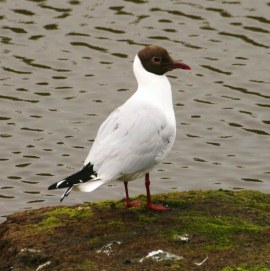Posted by Rebecca Nesbit | Last updated on April 4, 2025

Sometimes it isn’t ants that alert people to flying ant day, but raucous flocks of gulls. Flying ant day occurs once a year, around now, when winged black garden ants emerge in their millions ready to mate.

This is quite a spectacle, partly because of the birds it attracts. Thousands of gulls often loudly make their presence known where they aren’t normally present in large numbers. Often, they are nowhere near the sea. In fact, many of our species of ‘seagull’ will spend lots of time inland.
The gulls making the most of flying ant day include the herring gull and the black-headed gull. Black-headed gulls are smaller and daintier than herring gulls, and are the most common gull species seen inland. In the summer it is recognisable by its black head (actually chocolate brown) but it loses the colour over the winter. Like most gulls, black-headed gulls live for a long time, sometimes over 60 years.
Herring gulls are much larger, and their varied diet includes fish, crabs, smaller seabirds, birds eggs – and chips! But they also enjoy insects, including delicacies such as flying ants.
Another bird which knows flying ant day as feast day is the swift. These elegant birds feed, drink, mate and sleep on the wing, and only land to breed. When they leave the nest young swifts will go 2-3 years without landing!
Since launching the flying ant survey I have had some wonderful accounts of people’s experiences of flying ant day and I would love to hear yours. Please do add them to the comments below this blog post. If you have any questions about flying ants then please add them too: we will be putting ant questions to Dr Adam Hart from the University of Gloucestershire.
Also, look out for flying ant day and send in your records. Many of the records we’ve had so far have come from inside buildings and greenhouses – you can see them the map below. So there seem to be some winged ants waiting for a sunny day.
About Rebecca Nesbit
Dr. Rebecca Nesbit is an ecologist, author, and science communicator with a PhD in ecology from the University of York, completed in collaboration with Rothamsted Research. She works as press officer at the Royal Society of Biology and has led projects in fisheries science, clean tech, and offshore renewables. Her writing explores science and ethics, including her books Tickets for the Ark and Is That Fish in Your Tomato?. She also worked on airport bee-detection systems and toured with Nobel laureates as part of the Nobel Prize Inspiration Initiative.
Category: Society of Biology
